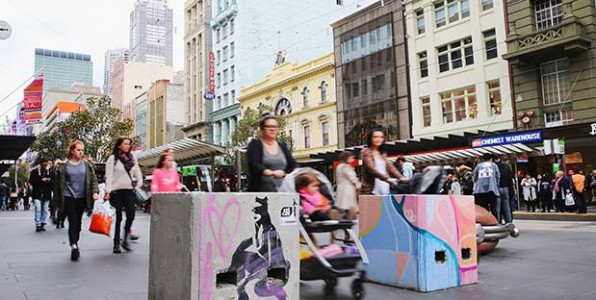
‘Boll-art’ permitted in Melbourne
by Yair Frid, onGraffiti Removal , September 5, 2017

by Yair Frid, onGraffiti Removal , September 5, 2017
After the attack in Bourke Street earlier in the year, where six people were killed and dozens were injured, around 200 concrete cubes were placed around the city as a protective measure to block vehicle attacks to pedestrians. The action seems to be more than necessary since the amount of this kind of attacks has been rising all over the world, including cities such as London and Berlin.
The dismal look of the grey cubes were not very well received by Melbourne dwellers and just a few days after they were placed, one of them was covered with a colourful and striped wrap. Later, some of the bollards were painted by graffiti artists and one of them, part of duo Cit Cat, was caught and stopped by police.
The artist was putting a paper sticker in one of the bollards when five police stopped him and threatened to be arrested. He was told to expect a summon for graffiti transgression. A police spokesman said that every artist painting the concrete cubes would be treated case by case.
Then the message got a bit confusing as the City of Melbourne said that the bollards were not owned by the council because they had only been rented because it is a temporary solution, therefore, they do not encourage people to paint on them.
The council also said that they were not planning to remove the art from the blocks even though they have equipment to remove the paint without significant costs. Melbourne Lord Mayor Robert Doyle then said that he supports the decoration of the blocks because it is creative and it gives a bit of a “middle finger” to terrorism, which was the main reason to put them there in the first place.
Mr Doyle actually put a challenge out for creative artists in the city, saying there are over 200 blocks and only a dozen have been painted. So he encourages the expression of creativity because the bollards will not be there forever, and in case the hiring company asks them in their original conditions, the graffiti cleaning crew can solve the problem. Even a competition for the best boll-art could be considered by the council.